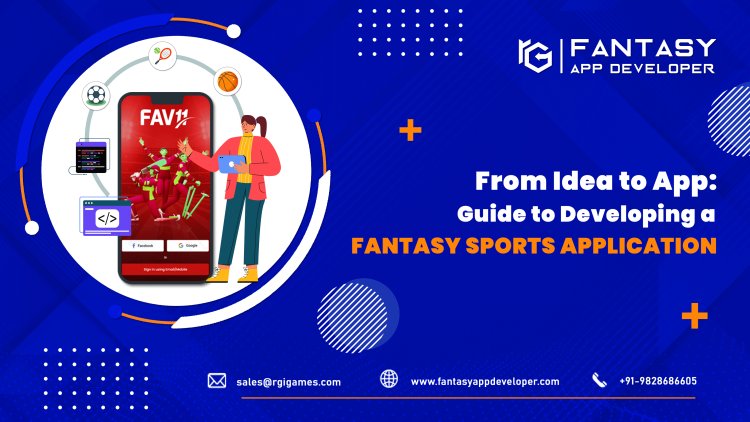From Idea to App: Guide to Developing a Fantasy Sports Application
According to Fantasy Sports Industry analysts, BY 2027 the business of Fantasy Sports Apps will have grown and will be valued at $40.88 billion.
Share this Post to earn Money ( Upto ₹100 per 1000 Views )

Fantasy Sports Solutions does a great job of bringing the real-world and virtual players together with the help of digital platforms but that does not mean that it will connect ordinary people with athletes and celebrities via video call or chat. Instead, they serve as an online platform for betting that offers interactive online games for users to take part in fantasy sports leagues.
These applications have gained huge popularity among sports fans looking for a more engaging online experience while streaming sports as a result of cutting-edge modern technology. With millions of users worldwide utilizing these apps, the fantasy sports market has experienced a boom in popularity.
What exactly are fantasy sports?
In online Fantasy Sports Solution, players take on the role of owners of fictional teams that compete with one another using data from genuine sporting events and real-world professional athletes. In a league or tournament format, participants usually select a team of real-life athletes before competing against one another. The stats of the athletes on the virtual teams of a player during actual games, such as the points earned, goals scored, and yards gained, all determine how many points they receive.
The players on the virtual teams typically come from many teams, and they are not confined to any particular region. Users get the chance to organize their leagues, invite friends, and engage in prize-winning competitions. In certain fantasy sports leagues, there is an admission fee, and the payments for the prizes might be modest or substantial.
Industry Size and Statistics for Fantasy Sports
There is clear evidence that the Fantasy Sports market is expanding significantly. The overall size of the fantasy sports market has increased from $25.44 billion in 2022 to $28.96 billion in 2018, rising at a compound annual growth rate (CAGR) of 13.24%.
BY 2027 the business of Fantasy Sports Apps will have grown and will be valued at $40.88 billion. According to data from the World Youth Report (2020), which predicts that by 2030, there will be more than 1.3 billion young people in the world, The key drivers of this rise are the growing youth population and expanding internet consumption.
What Are The Popular Types of Fantasy Sports Applications?
You may still have questions after reading the in-depth explanation, and one of the most commonly asked questions is about the relationship between fantasy sports and real-world sports. These applications are divided into four different categories because they use prediction-based games that are greatly influenced by the results of rare sporting events in real life.
-
Season-long Fantasy Sports: Before the start of the season, users select a team of real-life players, and they then play in a league against other users for the duration of the season.
-
Daily Fantasy Sports: Users compete against each other in brief competitions by selecting a team of actual players for a day’s worth of games or a week’s worth of matches
-
Pick Fantasy Sports: Users pick individual players or game outcomes rather than assembling a complete roster for the entire season.
-
Prediction markets: Users can purchase and sell shares of players depending on how well they are predicted to do in actual games, much like how stocks are exchanged on financial markets.
What are the major features of fantasy sports mobile apps?
A fantasy premier league app is a perfect solution designed to provide users with a unique and engaging experience by incorporating various features that set it apart from other software. Some of the essential features that a fantasy sports application should include are:
-
User profiles: Users can customize their experience by setting up a special account to save details about their team, league history, and preferences.
-
Leaderboards: Users can view their position about other players in the league with the function. Players may easily keep track of their advancement and engage in friendly competition with other users.
-
Player information: Players' statistics, performances, and injury status are all detailed information that users can access through the player information function. Users can utilize this to design their fantasy team and make informed judgments.
-
Dashboard for easy navigation: Users can easily access the various features and functionality thanks to the dashboard, which is a crucial component that allows for simple navigation throughout the app.
-
Manage money transfers for in-game purchases: With the help of this function, players can move money between different in-game accounts to make in-game purchases like adding new players or improving the performance of the team.
-
choices to build and join leagues: These choices let users start their leagues or join already-existing ones. Users can play with friends or join public leagues because of this flexibility.
-
Real-time activities and updates: Users can access this function to receive real-time updates on the games, player performance, and other pertinent data. Users can keep tabs on the Fantasy App Development and change their teams as necessary.
Conclusion
The above provided facts and information talk about Fantasy Sports App Development. Fantasy App Development and applications have gained huge popularity among sports fans looking for a more engaging online experience while streaming sports as a result of cutting-edge modern technology. With millions of users worldwide utilizing these apps, the fantasy sports market has experienced a boom in popularity.















